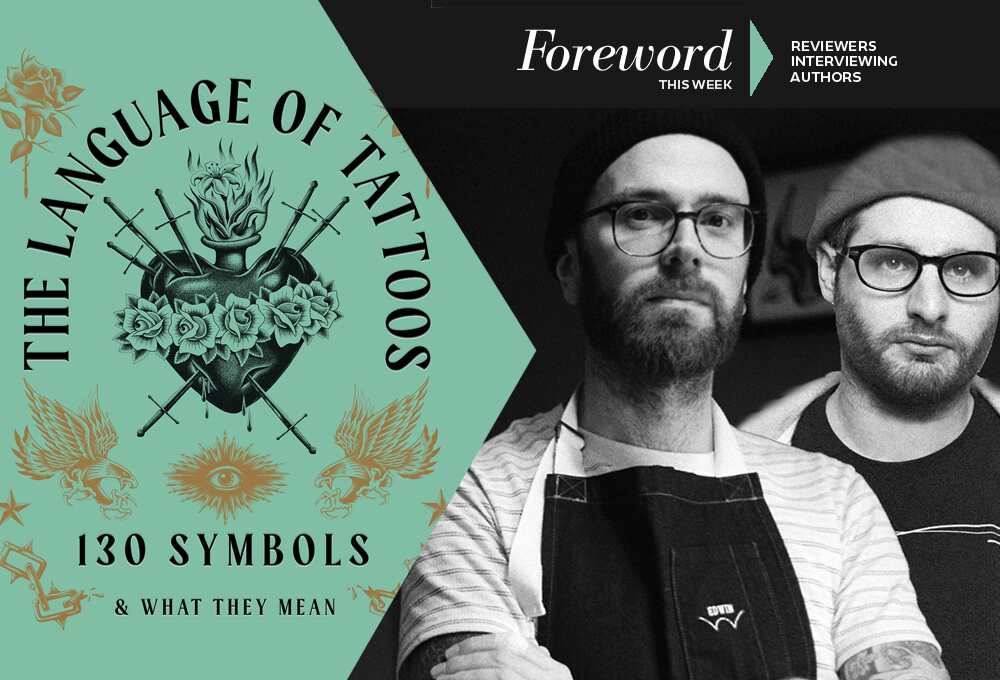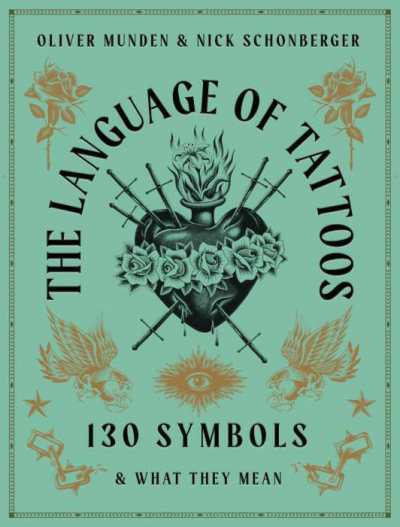Reviewer Rachel Jagareski Interviews Nick Schonberger and Oliver Munden, Author and Illustrator of The Language of Tattoos

No, your eyes don’t deceive you: if you’re under forty, more than 50 percent of your peers are sporting ink on their bodies, a dramatic increase from the generation prior. And while some hipsters choose their anchor or butterfly designs simply because they like the way it looks, most people gravitate toward images that hold special meaning. A tattoo is a lifetime commitment, after all.

This week, Nick Schonberger and Oliver Munden are with us to talk about the history and lore behind some of the more popular designs. Their book, The Language of Tattoos, looks at 130 of those symbols. In a recent review for Foreword, Rachel Jagareski calls it a “great resource for anyone contemplating some new body ink, or who is curious about tattoo history and the meaning behind the hearts, devils, and animals snaking over the communal epidermis.”
Rife with body ink of our own, our editorial office jumped at the chance to get Rachel in a conversation with Nick and Oliver—knowing that ink interest is all the rage.
Enjoy!
Your book decodes many tattoos and their original and contemporary symbolism. How did you plan your research on these images? Was a trove of historic flash sheets involved?
Nick: The book research involved synthesis of a variety of variety, inclusive of primary and secondary sources. Historic flash sheets, of course, allow for an investigation of image continuity over time. Over the past fifteen or so years, I’ve spent a lot of time looking at flash in museum collections, collecting examples when possible, and building a library of the brilliant flash-centered books that are on the market. Recently, a new trove of flash has been published and the material brought to light by Derin Bray’s Rake House, for example, was particularly useful in this study.
Ollie: Initially I compiled a pretty large list of imagery that I wanted to draw and chose many of the classic tattoo symbols that appeal to me and many of my customers. Putting a book like this together is a labour of love so I wanted to include all of my favourite images so that sitting to draw was never a task and always a pleasure.
Once I hashed out a fairly long list, we were still many symbols short—coming up with 130 symbols is no easy task—so Nick and I went back and forth adding and removing symbols—all the while making sure each category in the book had enough content to make it a worthy section.
Then it really was over to Nick to use his talent for research and to utilise his wealth of knowledge of tattoo history, in particular western traditional tattooing, although the book dips into Japanese and fine line style tattooing as well. I’m not sure how much of a treasure chest of flash sheets Nick has, but hopefully he’ll share a few with me if he’s sitting on a flash gold mine!
This question is for Olllie, who created all the wonderful illustrations for the book. How did you train as a visual and tattoo artist?
Ollie: Before tattooing, I worked as a designer and illustrator for around fifteen years. During that time I found myself more often than not pulling references from tattooing. I worked full-time at a couple of design studios but it was always very important to me to maintain a healthy presence in the design world under my own name, so I was always doing freelance work on the side. It was in this work that I made sure almost everything I did was inspired by tattooing and tattoo-style artwork since it was a huge interest of mine.
Around 2013 a publisher asked me to put together a colouring book of tattoo style designs. This book caught the eye of Leni NikiJuluw, who would later become the tattooist I would apprentice under. At first we were penpals, and a few times he did mention that he’d like to train me if I were ever interested. I was very flattered as, in honesty, I had always felt like a bit of a fraudster as an illustrator that drew tattoos, but didn’t actually tattoo people and was apprehensive of how I’d be received by the tattoo world in general. As with most things in life and as with art shows I’d put on, the thought was worse than the reality, and the reviews I received from within the tattoo world of my books and designs were positive, so to be asked to do an apprenticeship meant a great deal.
After two years I finally got to meet Leni and his wife, also a tattooist, at their shop Rock Steady Tattoo in Worthing on the South coast of England. We hit it off really well and I decided to go for it. It was a bit of a gamble as I was thirty five and had a mortgage and all of the other financial pressures of adult life, so jumping back to earning nothing was pretty tough. Thankfully the studio I was working for at the time allowed me to drop to part-time, which meant I could just about stay afloat whilst I began learning tattoo.
My apprenticeship was somewhat traditional but also fast-tracked; I learnt to take apart and tune machines, I swept, cleaned toilets (still do), mopped, worked the reception, and so on. For the traditionalists out there, I didn’t learn to make needles or clean tubes because we don’t have an autoclave at the shop, as we use all disposables. (If anyone is up for teaching me to make needles though I’d love to learn!) I signed myself up to Seth Ciferri’s Machine Machine course to learn further about tuning and tweaking traditional machines. I fell in love with using coil machines despite everyone else in the shop using tattoo pen style machines (except my brother who followed on after me to do an apprenticeship at the same shop).
I’m now five years into tattooing. Obviously Covid affected this business pretty hard, so I was very fortunate to fall back onto my illustration work, making things like The Language of Tattoos as well as doing the latest album art for Def Leppard this year with my brother Joshua.
Your chapter on tattoos of loss, memory, and transience is particularly poignant. You point out how cultural differences affect interpretation of skulls, crows, and memento mori images. What are your favorite images from this section?
Ollie: I am a big fan of the grim reaper design and had fun making that one. The more I tattoo the more I realise the importance of high contrast. I use a lot of heavy black against very subtle grey tones. The contrast makes the image pop and gives it a graphic nature, which I think is important for a tattoo to remain readable over time.
Nick: Personally, I’m always a bit fearful of darker motifs. That said, I love the variable potential of a skull design.
It was illuminating to read about how Victorian print culture so heavily influenced American advertising, media, and art then and continuing now. I definitely see the language of the calling cards represented in these designs. Why do you think these graphic images and their layers of meaning still resonate with people today?
Nick: These images retain power because of a universal legibility and the opportunity for subtle personalization.
You note that the fine-line tattoo style originated within the Chicano communities of Southern California and is now hugely popular worldwide and “informs a certain cool.” Can you elaborate on that and why you think this grisaille style is so popular?
Nick: It is such a beautiful, graceful style. As it has developed, and artists have applied the technique to wider subject matter, fine-line has also become one of the most adaptable of the figurative styles.
Do either of you sport some ink? If so, what kinds of tattoos are they and what personal meaning do they hold for you?
Nick: Fair to say we do. I mainly have tattoos based on traditional style (bold outlines and whip shading), and most come from flash books I have collected over the years.
Ollie: I started getting tattooed at age twenty-seven. My first design was a half sleeve Japanese style Koi fish piece which quickly became a full sleeve design. I used a lotus in this design which subtly linked to me coming out of a bit of a tough time, but in honesty and despite making this book, I very much believe if you like an image and want it tattooed then you should get it. There is nothing wrong with simply choosing a cool design. Equally, if you gravitate to a design and discover it also holds meaning to you—it’s a win-win situation!
After my sleeve I began collecting a lot of traditional style tattoos. I was working a lot in the USA in my early thirties and would try to get a tattoo in each city I visited—like permanent passport stamps I guess. I was tattooed on my thirtieth birthday by Eric Dressen, a legend in the skateboard community. I’ve also been tattooed in New York City, Portland, San Francisco, Los Angeles, Chicago, Barcelona, and of course in many shops here in England, so the collection has grown. I have plenty more planned but oddly I’ve slowed down a little now that I’m doing the actual tattooing.
Rachel Jagareski
